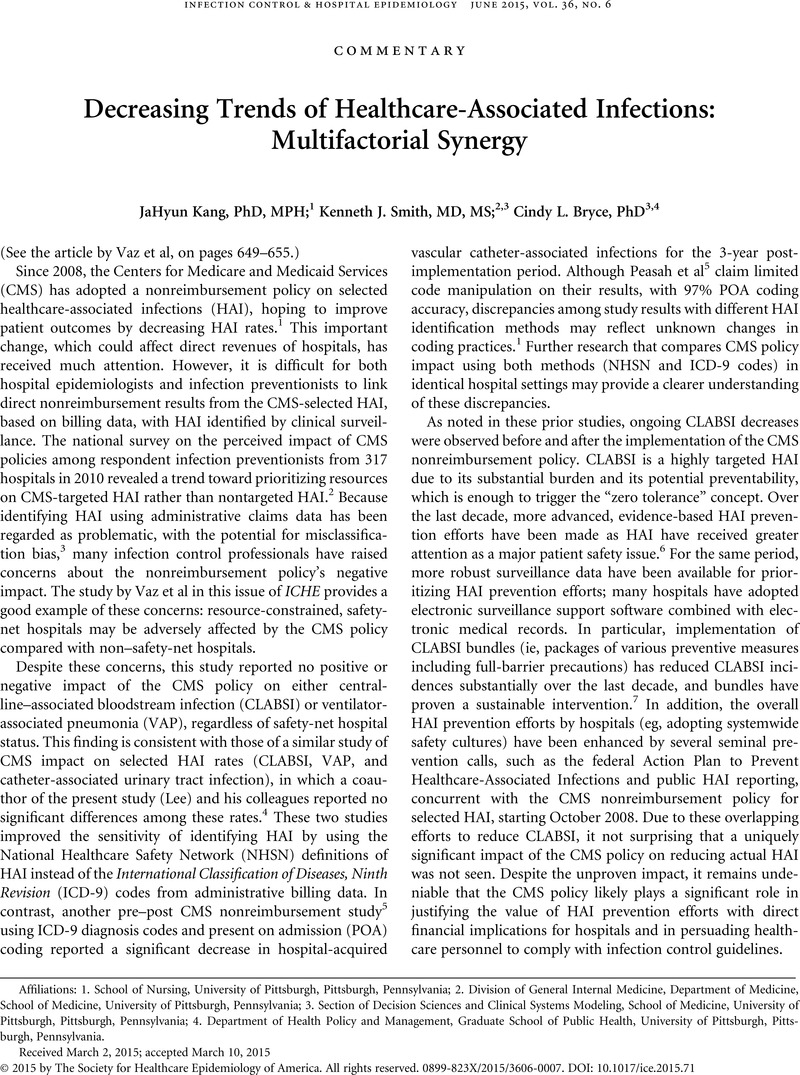No CrossRef data available.
Article contents
Decreasing Trends of Healthcare-Associated Infections: Multifactorial Synergy
Published online by Cambridge University Press: 21 May 2015
Abstract
An abstract is not available for this content so a preview has been provided. Please use the Get access link above for information on how to access this content.

- Type
- Original Articles
- Information
- Copyright
- © 2015 by The Society for Healthcare Epidemiology of America. All rights reserved
References
1.
Stone, PW. Changes in Medicare reimbursement for hospital-acquired conditions including infections. Am J Infect Control
2009;37:A17–A18.Google Scholar
2.
Lee, GM, Hartmann, CW, Graham, D, et al. Perceived impact of the Medicare policy to adjust payment for health care-associated infections. Am J Infect Control
2012;40:314–319.Google Scholar
3.
Edmond, M. Public reporting of healthcare-associated infection rates. In: Jarvis WR, eds. Bennett & Brachman’s Hospital Infections. 5th ed.
Philadelphia: Lippincott, 2007, Pp. 801–811.Google Scholar
4.
Lee, GM, Kleinman, K, Soumerai, SB, et al. Effect of nonpayment for preventable infections in US hospitals. N Engl J Med
2012;367:1428–1437.Google Scholar
5.
Peasah, SK, McKay, NL, Harman, JS, Al-Amin, M, Cook, RL. Medicare non-payment of hospital-acquired infections: infection rates three years post implementation. Medicare Medicaid Res Rev
2013;3:E1–E13.Google Scholar
6.
Burke, JP. Infection control—a problem for patient safety. N Engl J Med
2003;348:651–656.Google Scholar
7.
Pronovost, PJ, Watson, SR, Goeschel, CA, Hyzy, RC, Berenholtz, SM. Sustaining reductions in central line-associated bloodstream infections in Michigan intensive care units: a 10-year analysis. Am J Med Qual
2015, Epub ahead of print.Google Scholar
8.
Nurse staffing plans and ratios. American Nurses Association (ANA) website. http://www.nursingworld.org/MainMenuCategories/Policy-Advocacy/State/Legislative-Agenda-Reports/State-StaffingPlansRatios. Published 2014. Accessed February 25, 2015.Google Scholar
9.
McHugh, MD, Brooks Carthon, M, Sloane, DM, Wu, E, Kelly, L, Aiken, LH. Impact of nurse staffing mandates on safety-net hospitals: lessons from California. Milbank Qtrly Mar 2012;90:160–186.Google Scholar
10. Fiscal Year 2015 IPPS Final Rule Home Page 2015. Centers for Medicare and Medicaid Services website. http://www.cms.gov/Medicare/Medicare-Fee-for-Service-Payment/AcuteInpatientPPS/FY2015-IPPS-Final-Rule-Home-Page.html. Published 2015. Accessed February 28, 2015.Google Scholar


